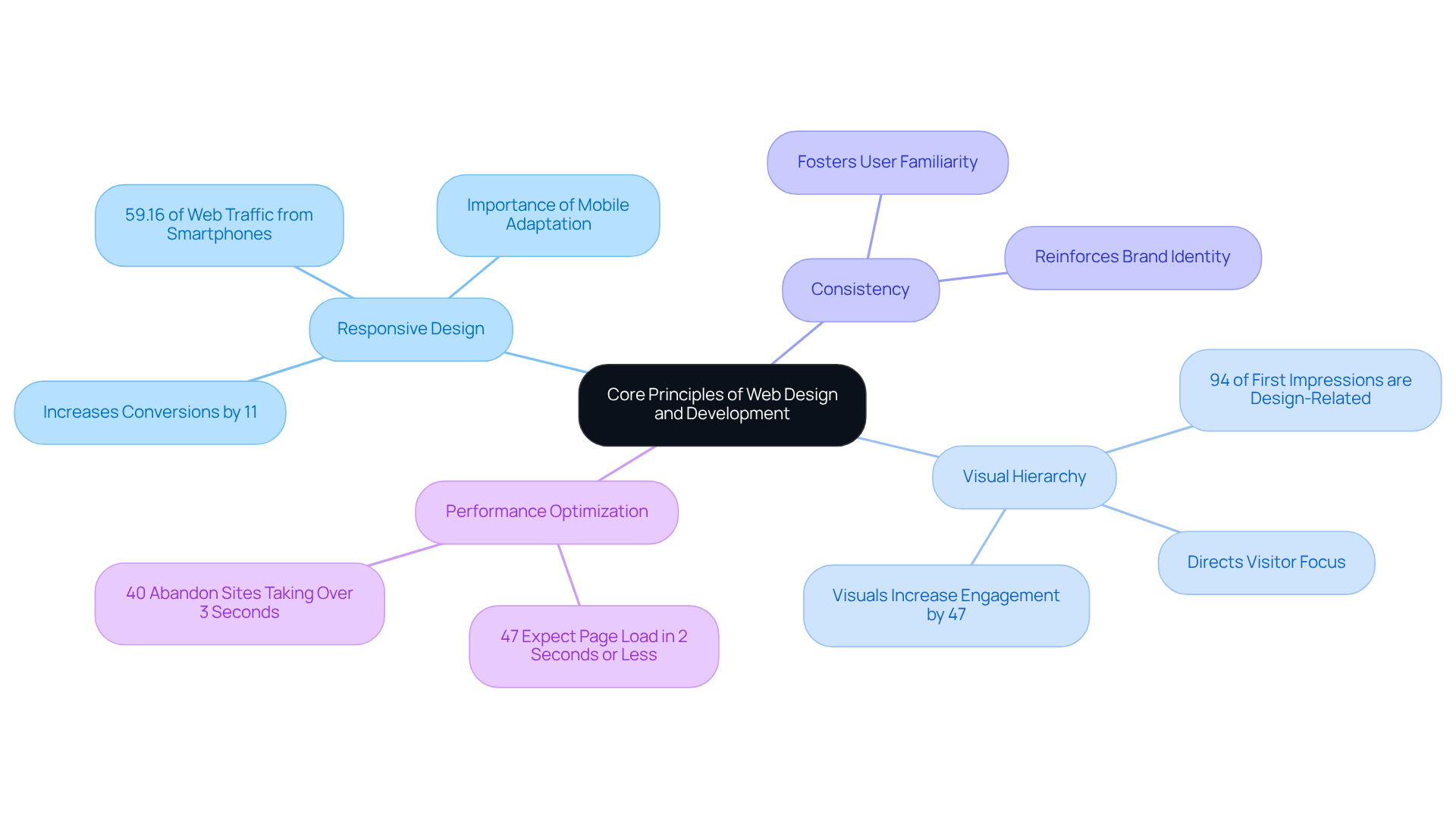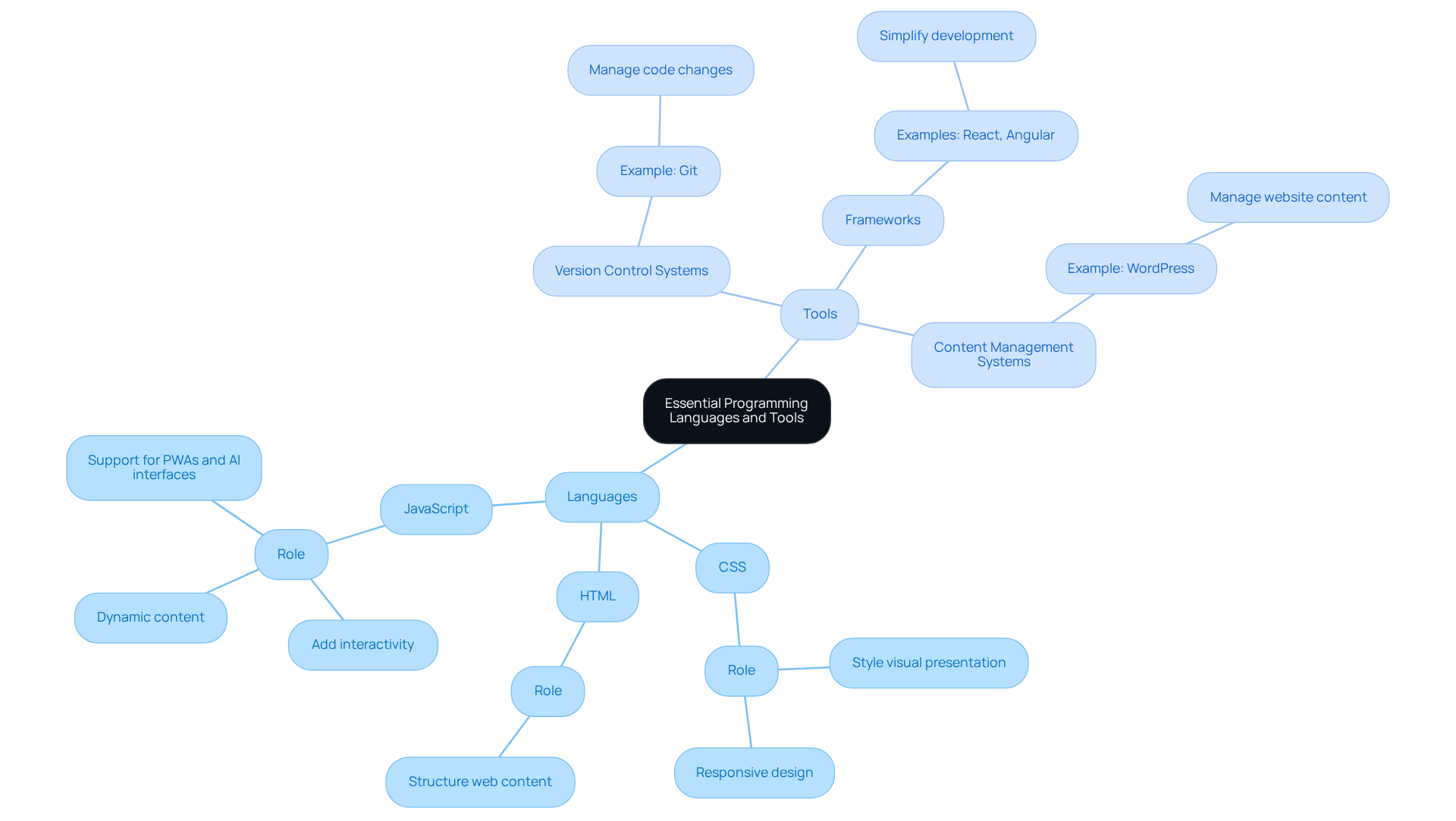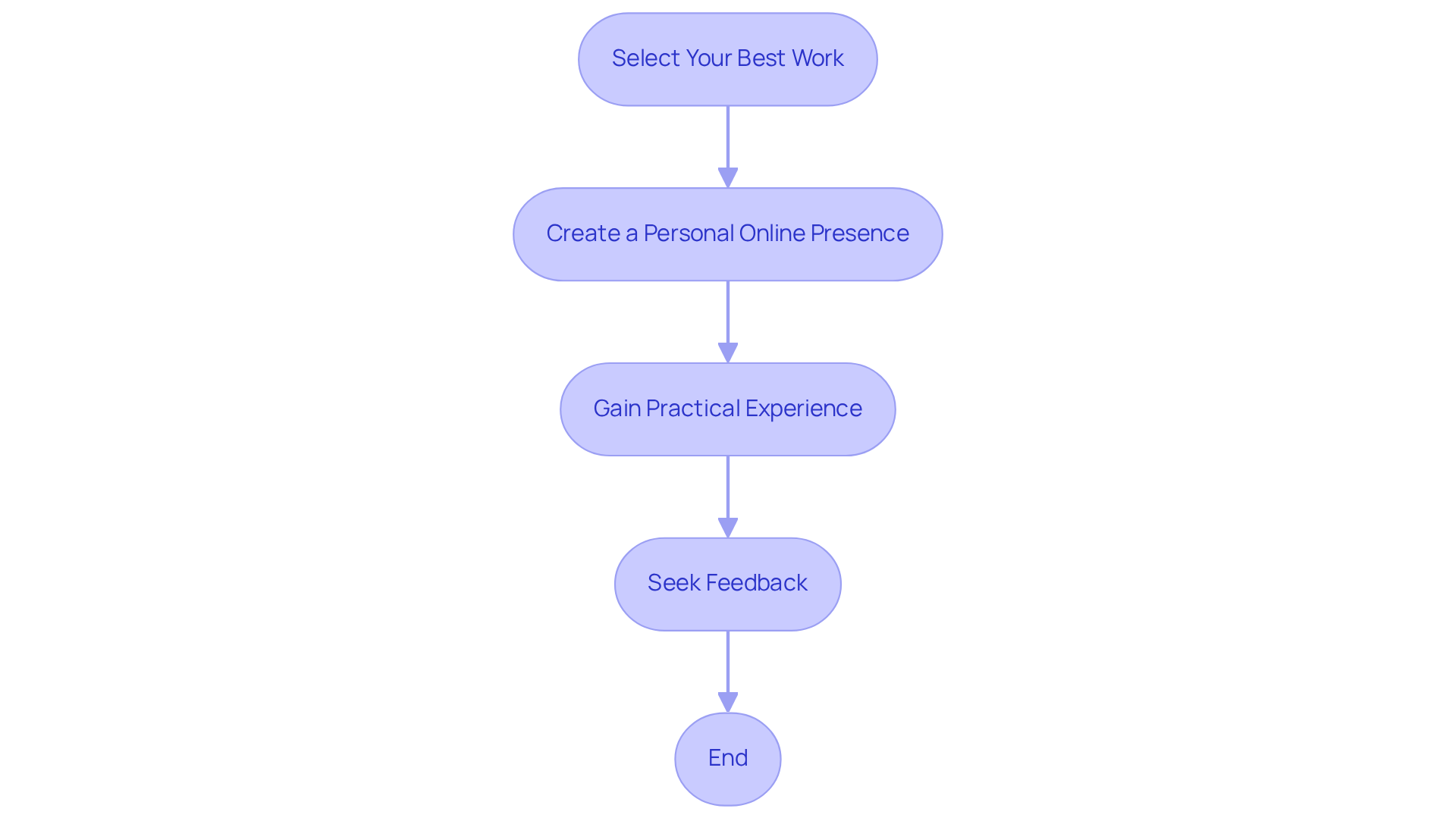Overview
In today's digital landscape, many tech startup founders face the challenge of creating effective websites that truly resonate with their audience. This problem can lead to frustration, as a poorly designed site often results in decreased user engagement and lower conversion rates. It's essential to recognize the impact that a website's design can have on meeting user needs and expectations.
To address this issue, it's crucial to focus on four key practices for effective website design and development:
- Responsive design
- Visual hierarchy
- Consistency
- Performance optimization
These practices not only enhance the visual appeal of a website but also ensure its functionality, ultimately creating a more satisfying user experience. Evidence shows that implementing these strategies can significantly improve user engagement and conversion rates.
By embracing these principles, you can create a website that not only looks great but also serves its purpose effectively. Remember, your website is often the first impression potential customers have of your brand, and it's vital that it reflects your commitment to quality and user satisfaction. Together, we can build a visually appealing and functional website that meets the needs of your users and supports your startup's growth.
Introduction
Establishing a strong online presence can feel overwhelming, especially for tech startup founders who are trying to navigate the complex world of website design and development. It’s common to feel lost among the myriad of choices and technical jargon. Understanding key practices like responsive design, user experience, and essential programming languages can seem daunting. Yet, these elements are crucial for creating websites that not only attract visitors but also turn them into loyal customers.
With technology evolving at a breakneck pace and user expectations constantly shifting, the question arises: how can you ensure your website stands out in such a crowded digital marketplace? By exploring these fundamental principles, you may discover the keys to unlocking a successful online platform.
Remember, you are not alone in this journey; many have faced similar struggles and emerged stronger. Let’s delve into these insights together, and find a path that resonates with your vision.
Understand Core Principles of Web Design and Development
Establishing a can feel overwhelming, especially for tech startup founders navigating the complexities of . It's crucial to understand some fundamental principles that can make this journey smoother and more rewarding.
- Responsive Design is a vital aspect; your website must adapt seamlessly to various screen sizes and devices. Did you know that 59.16% of web traffic comes from smartphones? This statistic highlights the necessity of , which not only enhances accessibility but can also boost conversion rates by 11%. Imagine the difference this could make for your business.
- Next, consider Visual Hierarchy. Structuring your content effectively directs visitors' focus to the most significant elements first. By strategically using size, color, and placement, you can enhance engagement. In fact, , with visuals increasing involvement by 47%. This underscores how essential visual hierarchy is in attracting viewer interest.
- Consistency is another key principle. Maintaining a uniform look and feel across all pages reinforces your brand identity and improves usability. When users experience consistency, it fosters familiarity, which is vital for .
- Lastly, don't overlook . Quick loading times and seamless interactions are essential for keeping your audience engaged. Research shows that 47% of individuals expect a web page to load in 2 seconds or less, while 40% leave sites that take more than 3 seconds. This can significantly impact your user retention.
By following these principles in website design and development, you can create an online platform that not only captivates visually but also operates effectively, ultimately increasing user engagement and conversions. As Chris Coyier wisely states, "100 times more important what you build than how you build it." Embrace these insights, and let them guide you toward a more successful online presence.

Master Essential Programming Languages and Tools
Creating and developing online platforms can feel overwhelming, especially when considering the complexities of along with the myriad of programming languages and tools to master. It's crucial to understand the foundational elements of website design and development that can make or break your web presence. Key languages to focus on include:
- HTML: Think of HTML as the backbone of your web content; it structures the information on your site, forming the essential foundation for all web pages.
- CSS: This language is your tool for styling the visual presentation of your website. It allows for customization and responsiveness to various devices, which is increasingly important as we anticipate that 60% of web traffic will come from mobile devices by 2025.
- JavaScript: , JavaScript significantly enhances visitor engagement. It serves as the backbone of modern web development, enabling real-time responsiveness and interactive features that keep your audience captivated. As technology evolves, JavaScript is adapting too, with innovations like Progressive Web Apps and AI-powered interfaces, underscoring its ongoing relevance in web development.
In addition to these languages, it's beneficial to :
- Version Control Systems (e.g., Git): These are vital for managing code changes and collaborating effectively with fellow developers.
- Frameworks (e.g., React, Angular): They can simplify development processes, allowing you to create complex user interfaces with less code.
- Content Management Systems (e.g., WordPress): These tools help you manage website content without needing extensive coding knowledge.
By mastering these languages and tools, you can bring your ideas for website design and development to life and ensure a smooth development process. Industry leaders emphasize that a well-crafted site can achieve than poorly designed counterparts, highlighting the importance of investing in . Moreover, the average conversion rate for online stores hovers around 2.8%, reinforcing the necessity for . Dr. Horst Stipp notes that faster online platforms not only enhance SEO but also improve conversion rates, making speed optimization a crucial aspect of website design and development. Quality assurance is equally important; it helps deliver a reliable website design and development and avoids common pitfalls in the development process. Remember, you are not alone in this journey, and with the right tools and knowledge, you can create a .

Prioritize User Experience and Interface Design
and interface creation should be at the forefront of your web development strategy. Many founders face the challenge of creating a website that truly resonates with users. It’s not just about aesthetics; it’s about . Key practices can help you navigate this journey:
- User-Centric Design: Always design with the end-user in mind. Conducting research to understand the needs and preferences of individuals is crucial. Did you know that ? This statistic highlights how essential design is to . and Amount illustrate how understanding client requirements can lead to innovative digital experiences that genuinely connect with target audiences.
- Intuitive Navigation: Users often struggle to find what they are looking for. It’s vital to ensure that your website allows for easy navigation. Clear labels and a logical structure for menus and links are essential. Significantly, , emphasizing its importance in retaining visitors. For example, , the “Uber” of Residential Cleaning, focuses on enhancing mobile app navigation to drive positive ROI.
- Accessibility: It’s essential to , including people with disabilities. Incorporating alt text for images and ensuring keyboard navigability are steps toward inclusivity. This commitment not only widens your audience but also improves the overall experience for all individuals. RNO1’s collaborations, including those with Healto and Source, highlight the importance of updating digital brands to meet diverse audience needs.
- Feedback Mechanisms: Implementing features that provide feedback on user actions, such as loading indicators or confirmation messages, can make a significant difference. This transparency helps users feel more in control and enhances their interaction with your site. RNO1’s approach to crafting , as seen in their partnership with TakeUp, showcases how effective feedback can improve audience engagement.
As Jesse James Garrett aptly stated, "The user experience is not one element of the creation—it is the creation." By prioritizing UX and interface aesthetics, you can create a website that not only attracts visitors but also keeps them engaged. This encourages repeat visits and fosters customer loyalty. Additionally, exemplifies how tailored digital experiences can significantly enhance customer engagement. Together, let’s create a nurturing environment where users feel valued and understood.
Build a Strong Portfolio and Gain Practical Experience
can feel daunting for web designers and developers engaged in , as they strive to distinguish themselves in a competitive market. This challenge can lead to feelings of uncertainty and overwhelm. However, by , you can that reflects your unique abilities and experiences.
- Select Your Best Work: Curating a collection of projects that showcases a diverse range of skills and design styles is essential. Including case studies that outline your creation process, the challenges you faced, and the results you achieved adds depth and context to your work. Remember, as Chris Coyier noted, "100 times more important what you build than how you build it," so focus on that resonate with your audience.
- : Leverage your web development expertise to craft a personal platform that serves as your portfolio. This not only highlights your technical abilities in website design and development but also acts as a for potential clients, enhancing your visibility in the industry. As Paul Rand stated, "To create is to transform prose into poetry," let your website tell your unique story and reflect your individual style.
- : Engaging in internships, freelance projects, or collaborations with other designers can provide you with invaluable hands-on experience. This not only enriches your portfolio but also opens doors to diverse learning opportunities that can shape your creative approach. Irene Etzkorn emphasizes that "there is no such a thing as a boring project since every client is unique," reminding us of the value in varied experiences.
- : Regularly asking for feedback on your portfolio from peers or mentors is a vital step in your growth. Constructive criticism can help you refine your work and presentation, ensuring that your portfolio remains relevant and impactful. As Alan Cooper mentioned, "If we want users to appreciate our software, we should create it to act like a pleasant individual: respectful, generous, and helpful," which also applies to how you showcase your portfolio.
By prioritizing these nurturing practices, you can effectively position yourself as a skilled and appealing candidate in the field of website design and development. Remember, as Scott Belsky aptly noted, "Rule of thumb for UX: More options, more problems," so focus on clarity and quality in your portfolio to attract the right opportunities and foster meaningful connections.

Conclusion
In today's digital landscape, establishing a strong online presence through effective website design and development can feel overwhelming for many businesses. The challenge lies not just in attracting visitors, but in nurturing them into loyal customers. By embracing key practices such as:
- Responsive design
- Visual hierarchy
- Consistency
- Performance optimization
you can create a website that resonates with your audience. Understanding and applying these principles is crucial; they can significantly enhance user engagement and drive higher conversion rates.
Many aspiring designers and developers grapple with mastering essential programming languages like HTML, CSS, and JavaScript. Utilizing tools such as version control systems and content management systems can feel daunting, but these are vital steps toward success. Prioritizing user experience and interface design through user-centric approaches, intuitive navigation, and accessibility ensures that your website speaks to the needs of your target audience. Building a strong portfolio and gaining practical experience are equally important in standing out in a competitive market.
In our rapidly evolving digital world, the significance of effective website design and development cannot be overstated. Embracing these best practices not only positions you for immediate success but also equips you to face future challenges with confidence. We encourage you to take action by implementing these strategies, continuously refining your skills, and creating impactful online experiences that truly meet the needs of your users. Remember, you are not alone on this journey; together, we can navigate the complexities of the digital landscape and foster meaningful connections with your audience.
Frequently Asked Questions
What is responsive design and why is it important?
Responsive design ensures that a website adapts seamlessly to various screen sizes and devices. It is important because 59.16% of web traffic comes from smartphones, and implementing responsive design can enhance accessibility and boost conversion rates by 11%.
How does visual hierarchy affect web design?
Visual hierarchy helps structure content effectively, directing visitors' focus to the most significant elements first. By using size, color, and placement strategically, it can enhance engagement, as 94% of first impressions are design-related, with visuals increasing involvement by 47%.
Why is consistency important in web design?
Consistency across all pages reinforces brand identity and improves usability. It fosters familiarity among users, which is vital for building trust and confidence in the brand.
What role does performance optimization play in web design?
Performance optimization focuses on ensuring quick loading times and seamless interactions, which are essential for keeping the audience engaged. Research indicates that 47% of individuals expect a webpage to load in 2 seconds or less, and 40% will leave a site that takes more than 3 seconds to load.
How can following these principles benefit a business's online presence?
By adhering to principles like responsive design, visual hierarchy, consistency, and performance optimization, businesses can create an online platform that captivates visually and operates effectively, ultimately increasing user engagement and conversions.




